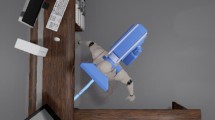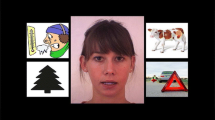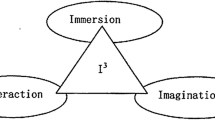Abstract
It is important to consider the physiological and behavioral mechanisms that allow users to physically interact with virtual environments. Inspired by a neuroanatomical model of perception and action known as the two visual systems hypothesis, we conducted a study with two controlled experiments to compare four different kinds of spatial interaction: (1) voice-based input, (2) pointing with a visual cursor, (3) pointing without a visual cursor, and (4) pointing with a time-lagged visual cursor. Consistent with the two visual systems hypothesis, we found that voice-based input and pointing with a cursor were less robust to a display illusion known as the induced Roelofs effect than pointing without a cursor or even pointing with a lagged cursor. The implications of these findings are discussed, with an emphasis on how the two visual systems model can be used to understand the basis for voice and gestural interactions that support spatial target selection in large screen and immersive environments.




Similar content being viewed by others
Abbreviations
- VR:
-
Virtual reality
- HCI:
-
Human–computer interaction
- ANOVA:
-
Analysis of variance
- CAD:
-
Computer-aided design
References
Sutherland IE (1965) The ultimate display. Proc IFIP Cong 65:506–508
Bolt RA (1980) “Put-that-there”: voice and gesture at the graphics interface. In: Proceedings of the 7th international conference on computer graphics and interactive techniques (SIGGRAPH), pp 262–270
Oviatt SL Cohen PR (2000) Multimodal interfaces that process what comes naturally. Commun ACM 43(3):45–53
Trevarthen CB (1968) Two mechanisms of vision in primates. Psychol Forsch 31:299–337
Milner AD, Goodale MA (1995) The visual brain in action. Oxford Psychology Series 27. Oxford University Press, New York
Bridgeman B, Peery S, Anand S (1997) Interaction of cognitive and sensorimotor maps of visual space. Percept Psychophys 59(3):456–469
Po BA, Fisher BD, Booth KS (2003) Pointing and visual feedback for spatial interaction in large-screen display environments. In: Proceedings of the 3rd international symposium on smart graphics, pp 22–38
Roelofs C (1935) Optische localisation (Optical localization). Archiv für Augenheilkd 109:395–415
Schneider GE (1969) Two visual systems: brain mechanisms for localization and discrimination are dissociated by tectal and cortical lesions. Science 163:895–902
Ungerleider LG, Mishkin W (1982) Analysis of visual behaviour. MIT Press, Cambridge, MA
Bridgeman B, Lewis S Heit, G, Nagle W (1979) Relation between cognitive and motor-oriented systems of visual position perception. Exp Psychol: Hum Percept Perform 5:692–700
Bridgeman B, Kirch M, Sperling A (1981) Segregation of cognitive and motor aspects of visual function using induced motion. Percept Psychophys 29(4):336–342
Michaels CF (2000) Information, perception, and action: what should ecological psychologists learn from Milner and Goodale (1995)?. Ecol Psychol 12(3):241–258
Kerzel D, Hommel B, Bekkering H (2001) A Simon effect induced by motion and location: evidence for a direct linkage of cognitive and motor maps. Percept Psychophys 63(5):862–874
Bridgeman B, Dassonville P, Bala J, Thiem P (2003) What is stored in the sensorimotor visual system: map or egocentric calibration?. In: Proceedings of the 3rd annual meeting of the vision sciences society, pp 10
Po BA, Fisher BD, Booth KS (2004). Mouse and touchscreen selection in the upper and lower visual fields. In: Proceedings of the ACM conference on human factors in computing (CHI), pp 359–366
Luckiesh M (1965) Visual illusions: their causes, characteristics, and applications. Dover Publications, New York
Myers BA, Bhatnagar R, Nichols J, Peck CH, Kong D, Miller R, Long AC (2002) Interacting a distance: measuring the performance of laser pointers and other devices. In: Proceedings of the ACM conference on human factors in computing (CHI), pp 33–40
Vicente KJ, Torenvliet GL (2000) The earth is spherical (p < 0.05): alternative methods of statistical inference. Theor Issues Ergon Sci 1(3):248–271
Acknowledgments
This research was funded by the Natural Sciences and Engineering Research Council of Canada (NSERC).
Author information
Authors and Affiliations
Corresponding author
Rights and permissions
About this article
Cite this article
Po, B.A., Fisher, B.D. & Booth, K.S. A two visual systems approach to understanding voice and gestural interaction. Virtual Reality 8, 231–241 (2005). https://doi.org/10.1007/s10055-005-0156-2
Published:
Issue Date:
DOI: https://doi.org/10.1007/s10055-005-0156-2




